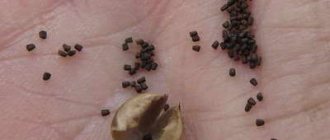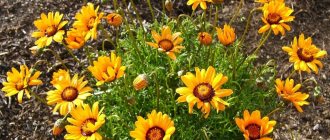Author: Natalya Category: Garden plants Published: December 21, 2018Republished: February 22, 2019Last edits: November 4, 2020
- Rules of care
- Bryozoan (Sagina saginoides)
Bryozoan (lat. Sagina) is a genus of flowering plants of the Carnation family, which includes 20-30 species growing in the Northern Hemisphere, although some bryozoans can be found further south. The Latin name of the genus means “feed”: one of the representatives of the genus was intended for fattening pigs.
Planting and caring for bryozoans
- Planting: sowing seeds for seedlings - at the end of March or early April, transplanting seedlings into the ground - in mid-May.
- Flowering: throughout the summer.
- Lighting: bright sunlight.
- Soil: loamy and sandy loam.
- Watering: regular, evening, preferably by sprinkling. After planting the seedlings in the ground - daily, but as soon as they take root, they switch to watering 2-3 times a week.
- Feeding: nitrogen fertilizer - in early spring and early summer, phosphorus and potassium fertilizer - in early spring, summer and autumn.
- Reproduction: seeds, sods.
- Diseases: fungal infections.
- Pests: aphids.
Read more about growing bryozoans below.
Botanical description
Bryozoans are low herbaceous annuals or perennials up to 20 cm high with ascending, erect or recumbent stems forming sods. The stems contain narrow linear leaves up to 1.5 mm wide, merging at the base into a short sheath. Small white bisexual flowers up to 10 mm in diameter, solitary or collected in few-flowered inflorescences, are located on long pedicels. The fruit of the bryozoan is an oblong capsule with kidney-shaped seeds.
The most commonly cultivated species are bryozoan awl-shaped, or Irish moss. It is the planting and care of the awl-shaped bryozoan that forms the basis of this article.
Bryozoan subulate: how to grow an unpretentious lawn from Irish moss
- Type: clove
- Flowering period: June
- Height: 1-10cm
- Color: green, white
- perennial
- Winters
- Sun-loving
- Drought resistant
Traditional lawns require constant care, causing a lot of trouble for the owner of a country house. In order for the color of the grass to always remain bright green, the lawn must not only be mowed regularly, but also combed, fed, watered, and weeded from emerging weeds. In addition to the above operations, it is necessary to aerate the lawn, as well as timely reseeding lawn grass in faded and yellowed areas. Lawn care takes a lot of time and physical effort, so many people are thinking about an alternative option for decorating their outdoor space. It turns out that you can get an equally beautiful grass cover with the help of ground cover plants. Among the many types of these representatives of the plant world, landscape designers especially highlight the awl-shaped bryozoan, which is also called Irish moss. In nature, this beautiful and unpretentious plant can be found on rocky slopes in Ireland. It should be noted that the awl-shaped bryozoan is only called moss, but is not such.
Growing bryozoans from seeds
Sowing seedlings
Bryozoans are grown from seeds, which can be purchased at a garden pavilion or flower shop. They are sown at the end of March or beginning of April on top of a moist substrate placed in containers, consisting of equal parts of leaf and turf soil. Cover the crops with film and place them under bright but diffused light. At a temperature of 25˚C, seedlings appear within a week, and only when the bryozoan subulate seedlings begin to germinate en masse will it be possible to remove the film from the crops.
- Madder: properties and contraindications, cultivation
In the photo: Bryozoan moss
When the small green needles turn into tufts of bright green bristles, the seedlings are planted in larger containers or placed in separate pots.
When and how to plant
Bryozoan seedlings are planted in open ground in May, when warm weather sets in and the soil warms up well. The best place for bryozoans is an open sunny area, although Irish moss also grows in the shade, but then it forms less dense and dense cushions. The bryozoan prefers loamy or sandy soil.
How to plant and grow sedum on a plot
In heavy soil, before planting the seedlings, you need to add sand for digging. If the soil is suitable for growing bryozoans, you should definitely loosen it well to a depth of 10 cm, remove weeds and plant remains of the previous crop and level the surface of the area.
Seedlings are planted, keeping a distance of 5-10 cm between them. After planting, the area is watered.
Methods of propagation of bryozoan awl-shaped
There are only a few main types:
- Vegetative method.
- Propagation by seeds.
Vegetative method
It is also called the sod division method. A very simple way:
- From the entire area where the bryozoan grows, bunches are separated along with the top layer of soil and planted in new places. In the place of expected growth, small holes are dug with a depth of at least 15 - 18 cm. Next, prepared bunches are planted there.
- It is advisable to make the distance between new plantings from 20 to 40 cm.
- It is better to do this in the spring, then by autumn the new sown areas will delight you with fluffy pillows.
If you just want to increase the area of your lawn, you don’t have to touch the plant at all - it will reproduce by self-sowing.
Reproduction of bryozoan subulate by seeds
This method is intended for those who are planting this plant for the first time. You can immediately sow the seeds in open ground, but there is a method for pre-growing seedlings.
Growing seedlings
The process takes time. Especially if this is the first time you have decided to plant this plant on your site.
- Containers are taken and soil is placed in them, which should contain sand and peat.
- Next, the seeds are planted and the box is covered with film. It is necessary to maintain the temperature from +18 to +22 degrees.
- Seedlings are planted in March. A week after planting, small sprouts appear in a container with soil. As soon as they get stronger and grow to small caps, they are transplanted into separate pots.
- Picking is carried out when primary shoots appear.
- In May, seedlings can already be planted in open ground. The distance between bushes should not be less than 10 cm.
- Gravel and compost must be added to special holes.
Then water the plants almost every day so that the roots multiply faster and become stronger.
Planting with seeds
Seeds are planted in open ground either in winter, when the snow poured on top will serve as insulation and will prevent the plant from dying, or in early spring.
- Holes are first dug and a little humus is added. The seeds are covered with soil.
- It is also necessary to make a layer of sand, which will serve as drainage, because the bryozoan is afraid of too wet soil and may begin to rot in the fall.
In a year or two, the plant will already have grown and begin to bloom. Its seeds are very small, so it is recommended, of course, to first grow seedlings at home.
Sowing bryozoans in open ground
In areas with a warm climate, there is no point in wasting time growing seedlings: the seeds are sown directly into the ground. Planting of bryozoan awl-shaped is carried out before winter: simply scatter the seeds over the area, trying to distribute them evenly. When the snow begins to melt in the spring and saturate the soil with moisture, it will draw the seeds into the ground just as much as needed. The first bryozoan shoots will appear in mid-spring.
- Carrots: planting for winter 2021
Caring for bryozoans in the garden
Rules of care
In order for your Irish moss lawn to look attractive, you will have to take care of it: water it, feed it, and on the eve of winter, if severe frosts are expected with little snow, cover the lawn with spruce branches. If the winter is frosty but snowy, the bryozoan will not need shelter. The plant does not need cutting.
How to grow loosestrife, incl. and coin
Watering and fertilizing
The main care for bryozoans is regular watering. The first two weeks after planting the seedlings in the ground, watering the lawn should be daily, but as soon as the seedlings take root and become stronger, watering is reduced: even in a prolonged drought, the bryozoan is watered no more than 2-3 times a week. The most suitable method for moistening a moss grass lawn is sprinkling.
And keep in mind that Irish moss growing in an open area can only be watered in the evening, otherwise the sun will burn the greenery.
In the photo: Bryozoan flowering
For normal growth and development, the bryozoan needs to be fed. Ammonium sulfate, which is necessary especially in the first year of a plant’s life, must be applied in an amount of 45 g/m² twice per season: in early spring and early summer. Three times a year - in early spring, summer and autumn - the soil on the site is fertilized with superphosphate at the rate of 16 g/m². Potassium, which stimulates the rapid growth of shoots and the development of cold resistance, also fertilizes the area three times per season at the rate of 10 g/m².
Pests and diseases
From excessive moisture, the bryozoan can be affected by fungal infections, which can be eliminated with the help of fungicidal drugs. However, first of all, you need to review the watering regime, otherwise a relapse of the disease is possible.
Bryozoans also have problems that are not related to infections: with a sudden strong cold snap, it can freeze, but if you feed the plant with phosphates on time and in sufficient quantities, this will help the bryozoan quickly adapt to temperature changes and not die.
- Lobularia: cultivation, care, types and varieties
Growing bryozoans in moist clay soil, oversaturated with nitrogen fertilizers, can lead to the fact that the plant does not fall asleep and will continue to develop even under snow if it has fallen on still warm soil. As a result, the bryozoan may dry out.
In soil with high acidity and excess phosphorus, especially with excessive soil moisture, the plant may suffer from chlorosis: the leaves and stems of the bryozoan become pale yellow. You can cope with the problem by spraying the bryozoan with iron chelate.
Among the pests, the bryozoan can be attacked by green aphids, which are destroyed with an insecticide solution.
Reviews
Bryozoan subulate is an unpretentious plant that is not afraid of weeds. The perennial used to create a lawn does not require constant cutting. In addition, it is resistant to trampling. It is even recommended to walk on such a lawn as often as possible, because this only improves its appearance.
I discovered the subulate bryozoan several years ago and from a very unexpected perspective. The thing is that it sows well and does not require careful care. Today, all my garden paths are decorated with this perennial plant, and it has become a pleasure to walk along them. Bryozoan is very delicate, but at the same time quite stable. In addition, its flowers exude a pleasant aroma.
The plant is great. The awl-shaped bryozoan blooms very touchingly, with small, snow-white flowers that look like tiny stars. Growing a plant does not require knowledge, and even a novice gardener can cope with it.
Bryozoan is still not moss, but a perennial herbaceous plant that blooms with small white flowers. Unlike most mosses, bryozoans love the sun, but die from excess moisture. As for the disadvantages of this plant, I would note its untidy appearance in the spring. But, fortunately, this goes away quite quickly. Therefore, the perennial has much more advantages.
I sowed bryozoan subulate in the spring. It sprouted surprisingly very well and quite quickly, but when transplanted into open ground, most of the plants died. I never found out what caused this.
A stunning plant, but it lasted me just over two years and after another winter it was gone. No matter how I wrapped the bryozoan, I was unable to save it. In addition, every spring an unpleasant-looking “ball of moss” awaited me. Bryozoan is not practical as a lawn. It is best used in a small area to decorate a rock garden or create a Japanese garden.
Types and varieties
Bryozoan (Sagina saginoides)
Or the bryozoan , a slow-growing ground cover plant with a tap root system that forms carpets of dense cushions. The shoots of the bryozoan pressed to the ground are covered with small light green needle-shaped leaves. The plant blooms in early summer with a few white flowers.
In the photo: Bryozoan (Sagina saginoides)
Bryozoan (Sagina procumbens)
Or bryozoan midge - a widespread perennial from 2 to 10 cm in height with recumbent or slightly erect branched stems that easily take root at the nodes. Narrow-linear, sharp, fused base leaves of this species, from 2 to 10 mm long and up to 0.5 mm wide, are collected in multi-leaf rosettes. Generative and vegetative shoots extend from the leaf axils. Bisexual, small white flowers are located on thin long stalks.
In the photo: Bryozoan (Sagina procumbens)
Bryozoan subulata (Sagina subulata)
This is an evergreen perennial that forms small but thick cushions resembling moss, up to 8 cm high. The stems of the plant are creeping and branched, the leaves are small and opposite, the flowers are white, up to 5 mm in diameter. The awl-shaped bryozoan has been in culture since 1881. Along with the main species, plant varieties with yellow leaves are popular.
In the photo: Bryozoan subulata (Sagina subulata)
What is good about this lawn?
What is so interesting about a lawn grown from this perennial plant? This question is asked by all amateur gardeners and novice designers who have not yet encountered the awl-shaped bryozoan in their practice. It turns out that a lawn grown from Irish moss has many advantages, namely:
- the grass cover is never mowed (this is simply not necessary, since the height of the subulate bryozoan is only 5-8 cm);
- you can walk, run, jump on a lawn made of bryozoans without fear of trampling the grass cover (these types of influence only compact the covering and make it even more attractive);
- a dense carpet of bryozoan subulate does not leave any “loops” for weeds to germinate (although individual representatives of weeds can break through, but their targeted removal takes very little time);
- a lawn made of Irish moss does not need frequent watering, with the exception of dry periods when all plants without exception experience moisture deficiency;
- it grows quickly without human intervention, so damaged areas of the lawn are covered with new plants within a short time;
- when the perennial blooms, the lawn turns into a beautiful lawn covered with thousands of white dots;
- small flowers exude an amazing aroma, filling the air with the smell of honey.
All of the listed advantages will turn into disadvantages if you confuse the varieties of perennial plants and plant instead of subulate (white) bryozoan, recumbent bryozoan, which is considered a weed.
A blooming bryozoan lawn pleases with its beauty throughout the entire summer period, and there is practically no need to care for it.











